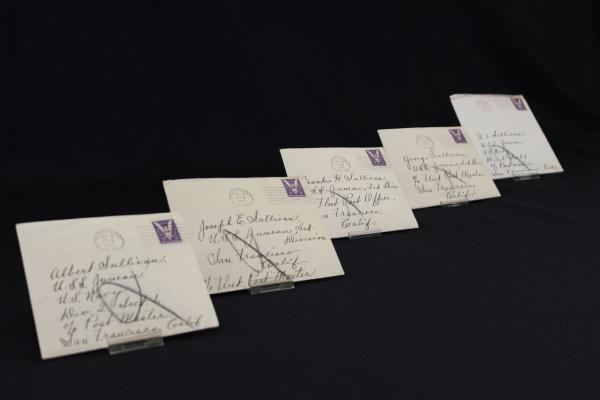The Sullivan Brothers
| Grade | 9th -12th Grades | Class | U.S. History | Length of Lesson | 4 Days |
| Lesson Title | The Sullivan Brothers |
| Unit Title | World War II - Supporting the War Effort |
| Unit Compelling Question | What kind of unique sacrifices did Iowan families make that made national headlines? |
| Historical Context: After the attack on Pearl Harbor in 1941, the brothers enlisted in the United States Navy with the understanding that they would serve together. After some hesitation, the Navy agreed and the Sullivans were assigned to the USS Juneau in February 1942. The ship was damaged at the naval battle at Guadalcanal and was destroyed on November 13, 1942, while on the way to be repaired. The Battle of Guadalcanal lasted from August 1942- February 1943 and was fought between American and Japanese forces near the Solomon Island of Guadalcanal in the South Pacific. Japanese troops landed on the island in July of 1942 and began to construct an airfield. In August, the Allies arrived and began to engage in their first major offensive in the Pacific theater as they attempted to shut down the airfield. By January, US troops were able to land on the island. By February, the Japanese were outnumbered and forced to evacuate the majority of their remaining troops. Throughout the battle, the Japanese lost a total of 24,000 men while the US lost 1,600, including the Sullivan brothers. The death of the brothers was due to a torpedo striking the ship from Japanese submarine I-26, causing the ship to explode. Believing all aboard the USS Juneau had died, Captain Gilbert C. Hoover of the nearby USS Helena, bypassed looking for any survivors and risking putting his own ship in danger. Instead the captain notified a US B-17 bomber to alert Allied headquarters to send other ships search for survivors. Unknown to Hoover, around 100 men had survived the attack. Because the call for a search became mixed up in other actions and miscommunication, the search did not begin until several days later. By that time, those who had initially survived had began to suffer from thirst, hunger, heat and even shark attacks. Eight days later, ten survivors were found by the PBY Catalina aircraft, who reported that while Joe and Matt had died instantly, Al drowned the next day and George survived for four days before passing from hypernatremia (high levels of sodium in blood). In addition to the Battle of Midway, the battle of Guadalcanal became a turning point in the Pacific theater. Each of the Sullivan brothers lost their lives on this day, and only ten sailors out of the 700 man crew survived. This marked the largest single-family combat loss in United States military history. While the Sullivan brothers passed away on November 13, 1942, their family was not notified right away. Charles and Nellie Turner, who were friends of the family and Waterloo residents, sent each of the brothers a Christmas card in December; however, the envelopes were never opened and were later returned to the Turners undelivered. The return of these envelopes served as one of the first clues as to what happened to the Sullivan brothers. The Sullivan family was officially notified about what happened to the brothers on January 11, 1943. After the death of the Sullivan brothers, the Putnam was renamed to The Sullivans by the Navy in honor of the brothers on February 10, 1943. The ship was sponsored by Alleta Sullivan (the mother of the brothers) and commissioned on September 30, 1943. The USS The Sullivans served until 1965 and in 1975 was donated to the Buffalo and Erie County Naval and Servicemen's Park. The second USS The Sullivans was commissioned in 1997 and runs under the motto "We Stick Together." The Sullivan Association was established to join together veterans who had served on either ship. The Sullivans' legacy lived on when the boys' hometown of Waterloo renamed the convention center "The Five Sullivan Brothers Convention Center" in 1988. Their story has also been portrayed in the 1994 film "The Fighting Sullivans" and is mentioned in the popular war film "Saving Private Ryan. ### These five envelopes, from the collection of the Five Sullivans Veterans Museum, Grout Museum District, contain Christmas cards sent to the five Sullivan brothers: George, Francis, Joseph, Madison, and Albert, in December 1942. The five Sullivan brothers were part of an Irish working class family who grew up in Waterloo, Iowa, during the Great Depression. Family was important to the Sullivan's and they were proud of their motto "we stick together." After the attack on Pearl Harbor in 1941, the brothers enlisted in the United States Navy with the understanding that they would serve together. After some hesitation, the Navy agreed and the Sullivans were assigned to the USS Juneau in February 1942. The ship was damaged at the naval battle at Guadalcanal and was destroyed on November 13, 1942, while on the way to be repaired. All of the Sullivan brothers died, and only ten sailors out of the 700 man crew survived. This marked the largest single-family combat loss in United States military history. |
|
| Lesson Supporting Question | |
| Lesson Overview | In this unit on “World War II, and Supporting the War Effort”, a brief break from the logistics of the war and the manufacturing efforts at home will be taken to discuss the historic “Sullivan Brothers”, who represented “the largest single-family loss in American military history”. This family was also the inspiration behind the movie “Saving Private Ryan”. After primary research on the Brothers, we will watch “Saving Private Ryan” which is inspired by the family but not even remotely accurate. It will be important for students to recognize how Hollywood can warp the accuracy of historical events. It will also be an enormous help while studying World War II for them to be able to see “Saving Private Ryan”. If for no other reason, the movie serves as an excellent visual representation of the horrors of D-Day and the war in general. This will provide a visual representation of the war for the next couple of weeks of talking about this critical time in American History. |
| Primary Sources Used |
|
| Resources Needed | Appendix 1 (In original lesson plan upload) |
| Standard | |
| Lesson Target | |
| Lesson Themes | World War II |
|
| Formative Assessment (How will you use the formative assessments to monitor and inform instruction?) |
Students will complete 2 assessment tasks in this 3-day mini-unit: Analysis of primary sources on the Sullivan Brothers and a demonstration of the degree to which “Saving Private Ryan” was historically inaccurate.○First, Students will submit their notes on the guided notes sheet for analyzing the primary sources. The first describes the life and story of the Sullivan Brothers, and the second shows the letters that were sent (but never delivered) to the Sullivan boys.○Second, students will write a brief “movie review” (2 pages, double-spaced, 12 point font) on the accuracy of the movie and what value the movie has in general. In the review, they will give the movie a rating out of 10 stars,and discuss 1) the depiction of the Sullivan family and its accuracy, and 2) the depiction of World War II and its |
| Summative Assessment (How does the lesson connect to planned summative assessment(s)?) |
| Author | Tristan Bernhard | Created | Last Edited | ||||
| Reviewer: Dr. Lisa Millsaps, University of Northern Iowa | |||||||
| Lesson Plan Development Notes: Teaching Methods, University of Northern Iowa, Fall 2018 | |||||||


